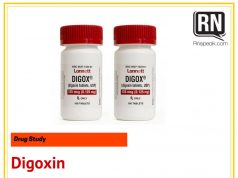Generic Name: Ranitidine
Brand Name: Zantac, Zantac EFFERdose, Zantac GELdose, Zantac-75
Classifications: gastrointestinal agent; antisecretory (h2-receptor antagonist)
Pregnancy Category:B
Availability
75 mg, 150 mg, 300 mg tablets; 150 mg effervescent tablets; 150 mg, 300 mg capsules; 15 mg/mL syrup; 0.5 mg/mL, 25 mg/mL injection
Actions
Potent anti-ulcer drug that competitively and reversibly inhibits histamine action at H2-receptor sites on parietal cells, thus blocking gastric acid secretion. Indirectly reduces pepsin secretion but appears to have minimal effect on fasting and postprandial serum gastrin concentrations or secretion of gastric intrinsic factor or mucus.
Therapeutic effects
Blocks daytime and nocturnal basal gastric acid secretion stimulated by histamine and reduces gastric acid release in response to food, pentagastrin, and insulin. Shown to inhibit 50% of the stimulated gastric acid secretion.
Uses
Short-term treatment of active duodenal ulcer; maintenance therapy for duodenal ulcer patient after healing of acute ulcer; treatment of gastroesophageal reflux disease; short-term treatment of active, benign gastric ulcer; treatment of pathologic GI hypersecretory conditions (e.g., Zollinger-Ellison syndrome, systemic mastocytosis, and postoperative hypersecretion); heartburn.
Contraindications
Safe use during pregnancy (category B) or lactation is not established.
Route & Dosage
Duodenal Ulcer,Gastric Ulcer, Gastroesophageal Reflux
adult: PO 150 mg b.i.d. or 300 mg h.s.
IV 50 mg q6–8h; 150–300 mg/24 h by continuous infusion
child: PO 4–5 mg/kg/d divided q8–12h (max: 6 mg/kg/d or 300 mg/d)
IM/IV 2–4 mg/kg/d divided q6–8h; 0.1–0.125 mg/kg/h by continuous infusion
infant: PO < 2 wk, 2 mg/kg/d divided q12h
IV 1.5 mg/kg/d divided q12h or 0.04 mg/kg/h by continuous infusion
Duodenal Ulcer,Maintenance Therapy
adult: PO 150 mg h.s.
Pathologic Hypersecretory Conditions
adult: PO 150 mg b.i.d. up to 6.3 g/d
IV 50 mg q6–8h
Heartburn
adult: PO 75 mg b.i.d.
Administration
Oral
- Give with or without food; simultaneous administration does not appear to reduce absorption or serum concentrations.Administer adjunctive antacid treatment 2 h before or after drug.
- Store tablets in light-resistant, tightly capped container at 15°–30° C (59°–86° F) in a dry place.
Intramuscular
- Note: Does not need to be diluted.
Intravenous
- Note: Verify correct IV concentration and rate of infusion for infants and children with physician.
PREPARE direct:Dilute 50 mg NS, D5W, RL, or other compatible IV solution to a total volume of 20 mL. intermittent: Dilute 50 mg in 50–100 mL of NS, D5W, RL, or other compatible IV solution. continuous: Dilute total daily dose in 250 mL of NS, D5W, RL, or other compatible IV solution. Final concentration should be <=2.5 mg/mL.
ADMINISTER direct:Give at a rate of 4 mL/min or 20 mL over not less than 5 min. intermittent: Give over 15–30 min. continuous: Give over 24 h.
Adverse effects
CNS:Headache, malaise, dizziness, somnolence, insomnia, vertigo, mental confusion, agitation, depression, hallucinations in older adults.
CV:Bradycardia (with rapid IV push).
GI:Constipation, nausea, abdominal pain, diarrhea.
Skin:Rash.
Hematologic:Reversible decrease in WBC count, thrombocytopenia.
BodyWhole:Hypersensitivity reactions, anaphylaxis (rare).
Nursing Implications
Assessment & Drug Effects
- Potential toxicity results from decreased clearance (elimination) and therefore prolonged action; greatest in the older adult patients or those with hepatic or renal dysfunction.
- Lab tests: Periodic liver functions. Monitor creatinine clearance if renal dysfunction is present or suspected. When clearance is <50 mL/min, manufacturer recommends reduction of the dose to 150 mg once q24h with cautious and gradual reduction of the interval to q12h or less, if necessary.
- Be alert for early signs of hepatotoxicity (though low and thought to be a hypersensitivity reaction): jaundice (dark urine, pruritus, yellow sclera and skin), elevated transaminases (especially ALT) and LDH.
- Long-term therapy may lead to vitamin B12 deficiency.
Patient & Family Education
- Note: Long duration of action provides ulcer pain relief that is maintained through the night as well as the day. Be aware that even if symptomatic relief is provided by ranitidine, this should not be interpreted as absence of gastric malignancy. Follow-up examinations will be scheduled after therapy is discontinued.
- Adhere to scheduled periodic laboratory checkups during ranitidine treatmentDo not supplement therapy with OTC remedies for gastric distress or pain without physician’s advice (e.g., Mylanta II reduces ranitidine absorption).
- Do not smoke; research shows smoking decreases ranitidine efficacy and adversely affects ulcer healing.
- Do not breast feed while taking this drug without consulting physician.







